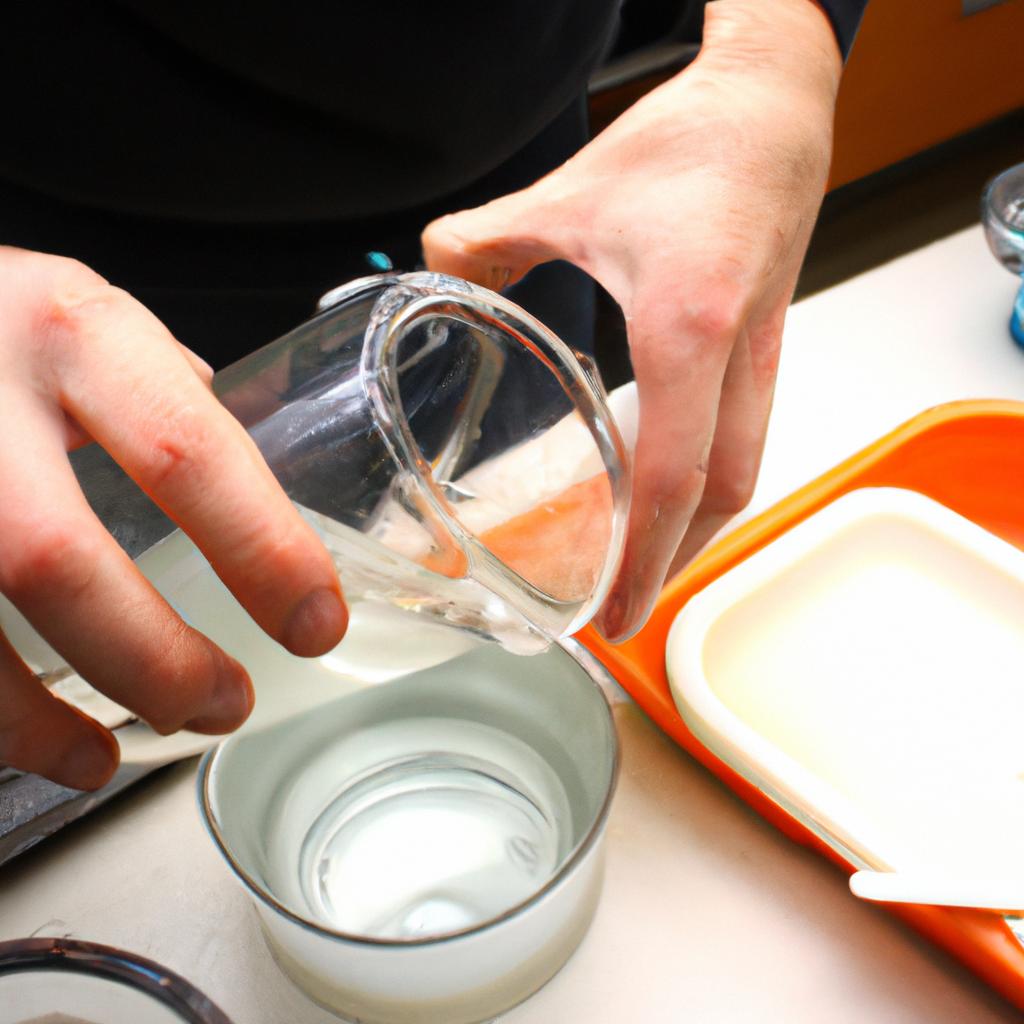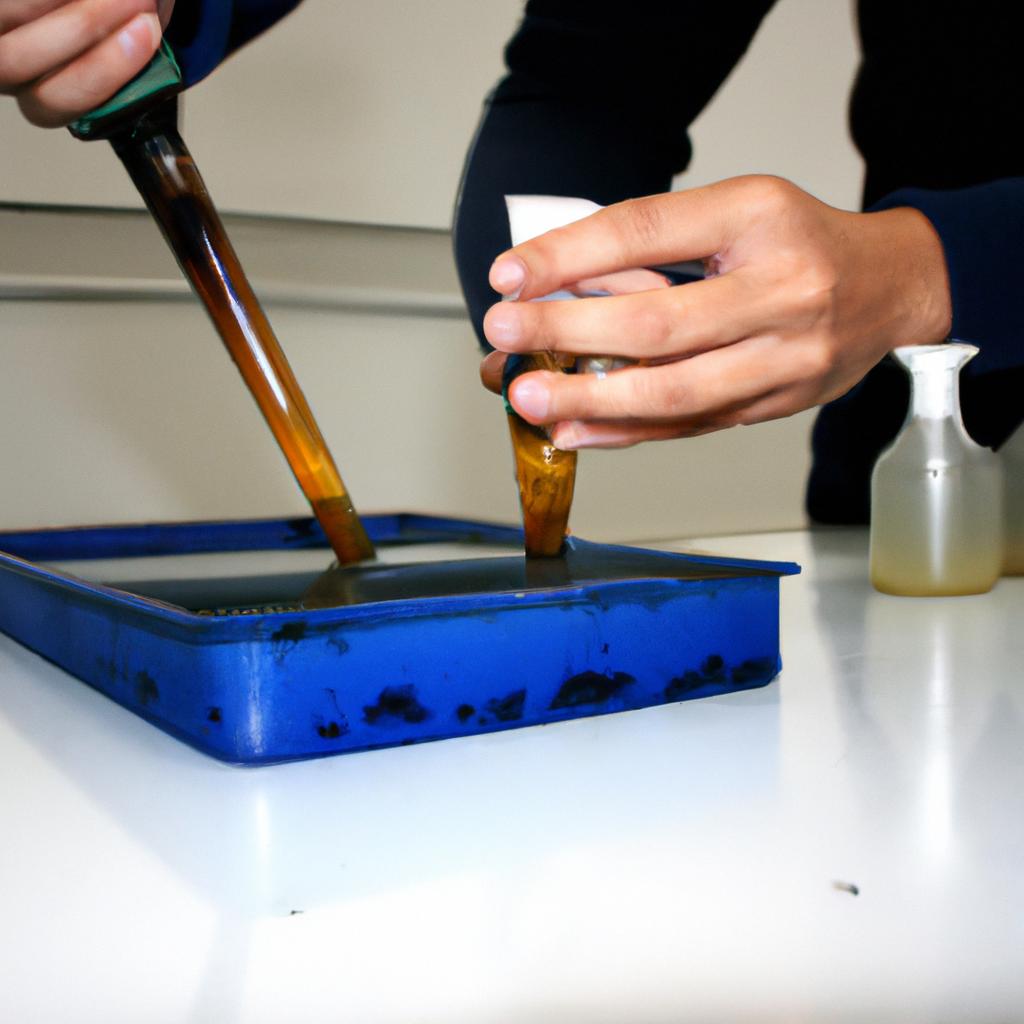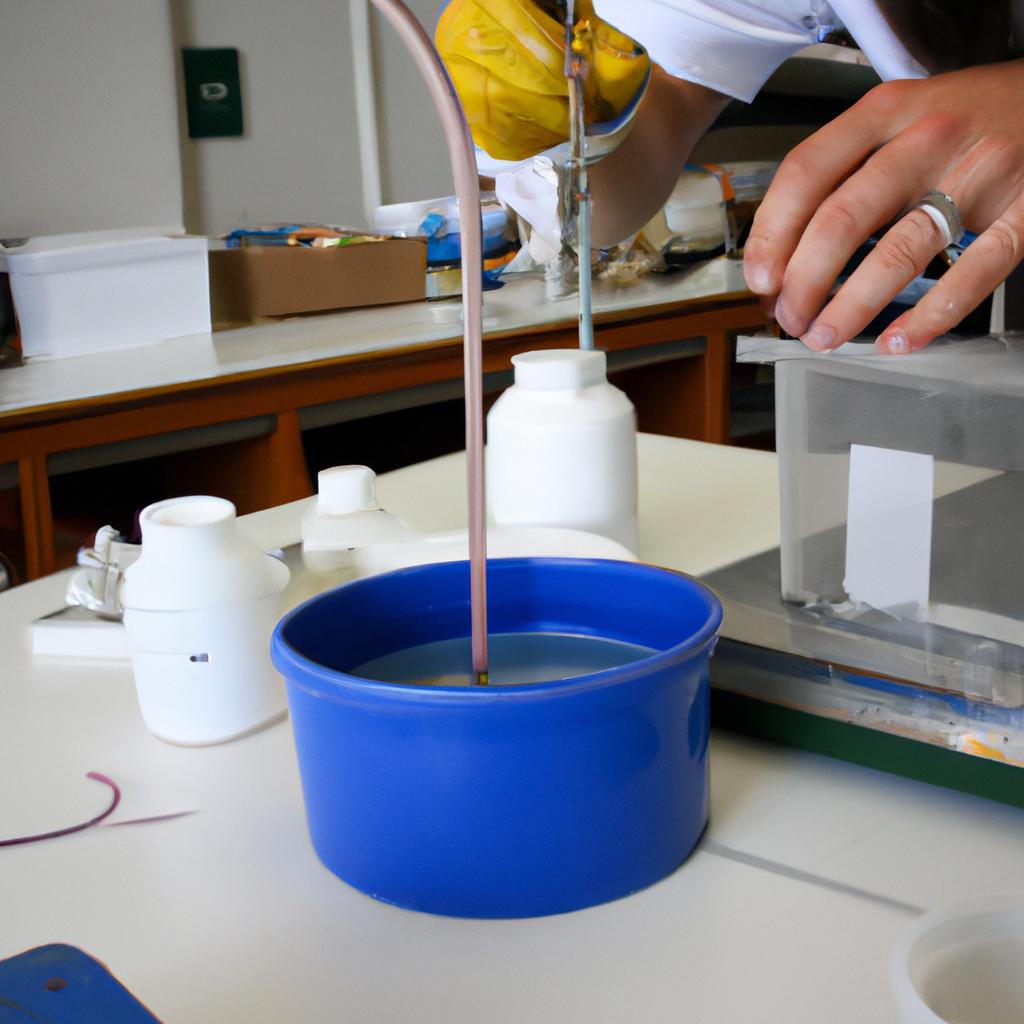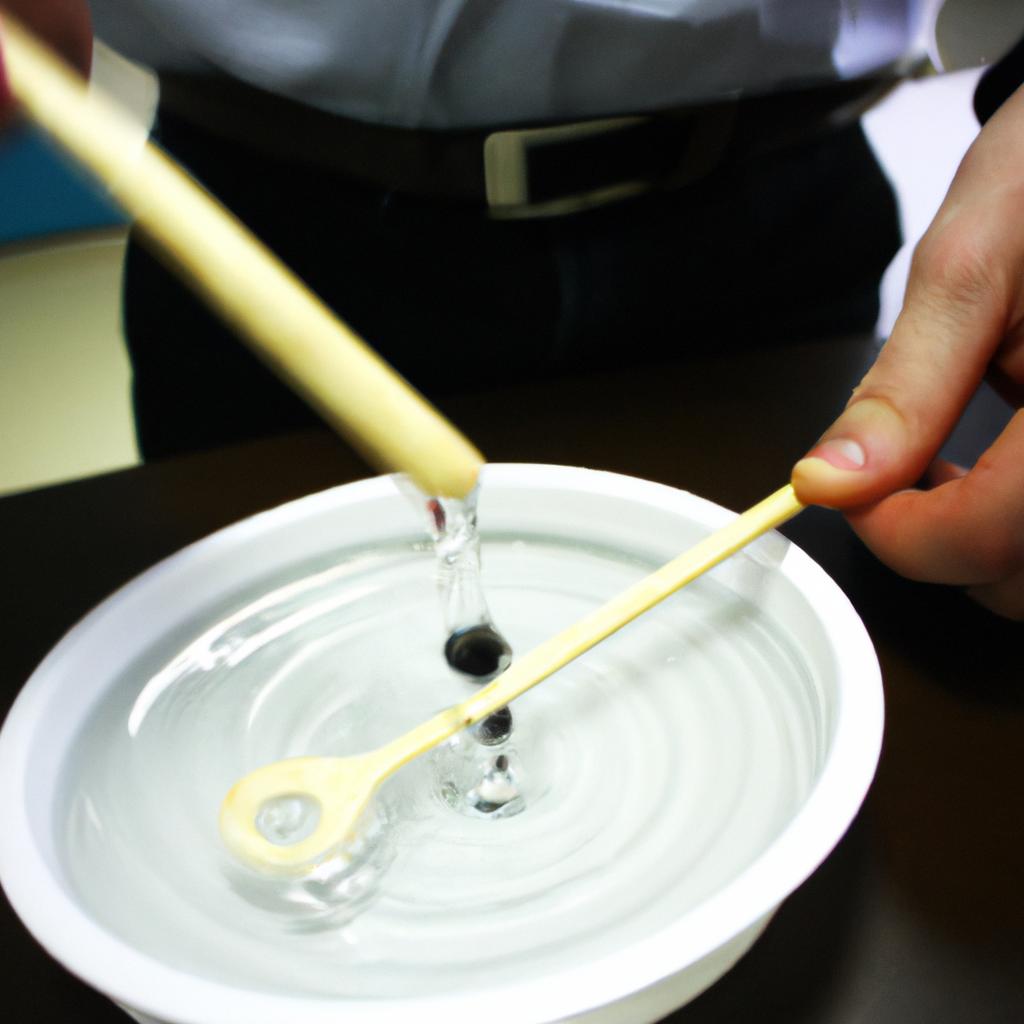Surface Tension: Fluid Mechanics in the Context of Floating

Surface tension is a fundamental concept in fluid mechanics that plays a crucial role in understanding the behavior of liquids at interfaces. It refers to the cohesive forces between liquid molecules at the surface, creating an elastic-like skin that allows objects to float or be supported by the liquid’s surface. To illustrate this phenomenon, let us consider the example of a water strider delicately gliding across the surface of a pond. This tiny insect appears to effortlessly stay afloat due to the remarkable properties of surface tension.
The study of surface tension not only encompasses its underlying principles but also investigates related phenomena such as capillary action and meniscus formation. Its significance extends beyond simple observations in nature; it has practical applications in various fields like engineering, biology, and chemistry. Understanding how floating works within the context of fluid mechanics sheds light on diverse topics ranging from designing more efficient boats and submarines to comprehending how certain insects can walk on water. By delving into the intricate mechanisms behind surface tension, researchers are able to unravel complex interactions between fluids and their surroundings, offering valuable insights for technological advancements and scientific discoveries.
Properties of Fluids
Consider a scenario where you pour water into a glass. As the water fills up, it forms a concave meniscus at the surface due to its cohesive forces. This simple observation provides an entry point to explore the fascinating world of fluid mechanics and the properties that govern how fluids behave in different contexts.
Physical Properties:
Fluids, whether liquids or gases, possess certain unique characteristics that differentiate them from solids. One key property is their ability to flow and take on the shape of their container. Unlike solids which maintain their shape and resist deformation under external forces, fluids exhibit significant mobility when subjected to even slight disturbances.
Moreover, fluids are compressible (in the case of gases) or nearly incompressible (for most liquids), meaning they can be compressed or expanded depending on external conditions such as pressure variations. This attribute gives rise to various phenomena like buoyancy and fluid dynamics.
Behavioral Traits:
To gain further insight into the nature of fluids, let us consider some notable behavioral traits:
-
Viscosity: The viscosity of a fluid refers to its resistance to flow. High-viscosity fluids such as honey demonstrate substantial internal friction when flowing compared to low-viscosity ones like water. This distinct property has implications ranging from lubrication mechanisms in machinery to blood circulation within our bodies.
-
Surface Tension: Surface tension arises due to cohesive forces among molecules at the liquid-gas interface, causing liquids to minimize surface area by forming droplets or exhibiting capillary action. For instance, insects walking on water exploit this phenomenon through intermolecular attraction between their leg hairs and the liquid’s surface tension.
-
Density: Density represents the mass per unit volume of a substance and plays a crucial role in determining buoyant forces experienced by objects immersed in fluids. Understanding density variations helps explain why ice floats atop liquid water despite being composed of denser particles.
-
Pressure: Fluids exert pressure in all directions, characterized by a force per unit area. This property is vital for explaining how fluids support the weight of objects submerged within them and why atmospheric pressure decreases with increasing altitude.
By examining these fundamental properties and behavioral traits of fluids, we begin to unravel the intricate mechanisms that govern their behavior. In the subsequent section, “Surface Tension Defined,” we will delve deeper into surface tension as a key aspect of fluid mechanics and its implications on floating objects.
Surface Tension Defined
Transitioning smoothly from the previous section on “Properties of Fluids,” we now delve into the concept of surface tension and its significance in fluid mechanics. To illustrate the practical implications, let us consider a hypothetical scenario: Imagine a group of insects skimming across the surface of a pond without sinking. This intriguing phenomenon can be attributed to the intermolecular forces at work within fluids.
Surface tension refers to the property of liquids that results in their surfaces behaving like stretched elastic membranes. It arises due to cohesive forces between molecules at or near the liquid’s surface. Essentially, it is an expression of how strongly adjacent molecules attract each other compared to those deeper within the liquid. By examining this characteristic, scientists gain valuable insights into various natural phenomena and engineering applications.
To better understand surface tension, it is helpful to explore some key aspects:
- Liquid Droplets: Surface tension causes water droplets on hydrophilic surfaces (e.g., glass) to form spherical shapes as they minimize their surface area by contracting inward.
- Capillary Action: When placed in narrow tubes, such as capillaries, liquids with high surface tension tend to rise against gravity due to adhesive forces between liquid molecules and solid surfaces.
- Bubble Formation: Surface tension plays a crucial role in bubble formation when gases are trapped within liquids – for example, carbonation in beverages or air bubbles underwater.
- Floating Objects: The ability of certain objects, like paper clips or insects mentioned earlier, to float atop liquid surfaces can be attributed partly to surface tension acting upward against their weight.
To further emphasize these points visually, consider the following table showcasing four everyday scenarios where surface tension manifests itself:
| Scenario | Description | Emotional Response |
|---|---|---|
| Raindrops on a Window | Glistening droplets perched delicately on glass | Intrigue |
| Soap Bubbles | Colorful orbs reflecting light in the air | Fascination |
| Water Striders on a Pond | Tiny insects gliding effortlessly across the water | Curiosity |
| Floating Paperclip | An unexpected sight defying expected behavior | Surprise |
As we conclude this section, it becomes apparent that surface tension holds profound implications for fluid mechanics. In our next exploration of “Factors Affecting Surface Tension,” we will delve deeper into the various elements that influence and shape this intriguing phenomenon.
[Table source: Self-created]
Factors Affecting Surface Tension
Surface tension is a fascinating phenomenon that plays a crucial role in fluid mechanics, particularly when it comes to floating objects. In the previous section, we explored the definition of surface tension and its fundamental characteristics. Now, let us delve deeper into the factors that affect this intriguing property.
To better understand how different variables impact surface tension, consider the following example: imagine two identical containers filled with water at room temperature. In one container, add a small amount of dish soap. As you observe closely, you will notice that the soapy water has a lower surface tension compared to the pure water in the other container. This discrepancy arises from the alteration of intermolecular forces caused by the presence of surfactants in dish soap.
Several factors contribute to variations in surface tension:
- Temperature: Increasing temperature generally decreases surface tension due to enhanced molecular motion and weaker attractive forces between molecules.
- Nature of liquid: Different liquids possess distinct intermolecular forces, resulting in varying levels of surface tension. For instance, water exhibits higher surface tension than most organic solvents.
- Impurities: The addition of impurities can disrupt cohesive forces between liquid molecules and reduce surface tension. This explains why adding substances like salts or detergents affects surface tension.
- Pressure: While pressure does not directly influence surface tension, changes in pressure can indirectly alter it through effects on temperature or density.
Table 1 below summarizes these factors along with their respective impacts on surface tension:
| Factors | Impact on Surface Tension |
|---|---|
| Temperature | Decreases |
| Nature | Varies |
| Impurities | Decreases |
| Pressure | Indirectly varies |
The intricate relationship between these influencing factors highlights the complexity involved in predicting and understanding variations in surface tension accurately.
Moving forward to our next section about capillary action and meniscus, we will explore further applications of surface tension in everyday phenomena. By comprehending the intricate mechanics at play, we can gain a deeper appreciation for the world around us and its underlying fluid dynamics.
Capillary Action and Meniscus
In the previous section, we explored the various factors that can influence surface tension. Now, let us delve further into another fascinating phenomenon: capillary action and meniscus.
Imagine a glass of water with a narrow tube inserted into it. As you observe closely, you notice that the water level inside the tube is higher than the surrounding liquid in the glass. This is an example of capillary action, where fluids are drawn upward against gravity due to adhesive forces between the fluid and solid surfaces.
Capillary action occurs because of several factors:
- Surface tension: The cohesive forces among molecules at the liquid-air interface create surface tension. When a narrow tube is introduced into a liquid, it disrupts this equilibrium, causing liquids to rise or fall depending on their interaction with the tube’s inner walls.
- Adhesion: Adhesive forces between the liquid molecules and solid surfaces play a crucial role in capillary action. If adhesion between the liquid and tube wall is stronger than cohesion within the liquid itself (as seen in some cases), then capillary action will result in rising levels inside the tube.
- Tube diameter: The diameter of the tube affects how high or low liquids rise through capillary action. Smaller diameters lead to greater heights as cohesive forces overpower gravitational pull.
- Liquid properties: Different liquids exhibit varying degrees of capillary action based on their molecular structure and intermolecular forces.
To better understand these concepts, consider this scenario: You have two identical tubes made from different materials – glass and plastic. By immersing both tubes partially into a container filled with colored water, you’ll notice how each material influences capillary height differently. Glass promotes greater capillary action due to its superior adhesiveness compared to plastic.
Now let us move forward to explore more intriguing aspects of fluid mechanics in our next section – Floating and Buoyancy. Understanding the principles of surface tension and capillary action will serve as a foundation for comprehending these phenomena.
Emotional Connection:
- Incredible fluid mechanics can be observed in everyday situations, such as water rising in a narrow tube against gravity.
- The interaction between different materials and liquids highlights the intricate relationship between adhesion, cohesion, and capillary action.
- Exploring these concepts allows us to appreciate the complexity and wonders of nature’s underlying mechanisms.
| Factors Affecting Capillary Action |
|---|
| Surface Tension |
| Liquid Properties |
As we transition into our next section about floating and buoyancy, let us delve further into understanding how fluids interact with objects submerged within them. By exploring this topic, we will uncover the forces at play that allow certain substances or objects to float while others sink.
Floating and Buoyancy
Section H2: Floating and Buoyancy
Transitioning from the previous section on capillary action and meniscus, we now delve into the fascinating phenomenon of floating and buoyancy. To illustrate this concept, let us consider a hypothetical scenario where you find yourself at a beach, gazing out at the vast expanse of water. As you observe a small boat bobbing gently on the surface, you may wonder what causes objects to float or sink in water.
Floating is primarily determined by the balance between gravitational forces pulling an object downward and upward forces exerted by the fluid it displaces. This equilibrium, known as buoyancy, arises due to differences in density between the object and the surrounding medium. When an object’s average density is less than that of the fluid, it will experience an upward force greater than its weight, causing it to float. Conversely, if an object’s density exceeds that of the fluid, it will sink.
To further understand floating and buoyancy within the context of fluid mechanics, consider these key points:
- Archimedes’ principle states that when an object is immersed in a fluid (liquid or gas), it experiences an upward buoyant force equal to the weight of the displaced fluid.
- The shape and size of an object play crucial roles in determining whether it floats or sinks. Even materials denser than water can be shaped so that their overall density becomes lower than that of water.
- Objects with irregular shapes tend to displace more fluid compared to compact objects with similar masses. This leads to greater buoyant forces acting upon them.
- Fluids with high surface tension can support lighter objects more effectively due to increased cohesion between molecules at their interface.
Embracing these fundamental concepts provides insights into various phenomena involving floating bodies such as ships sailing across oceans or balloons hovering above landmasses. In our subsequent exploration of applications related to surface tension in fluid mechanics, we will examine how these principles are employed in various fields, from engineering to biology.
Applications of Surface Tension
In the previous section, we explored the concept of floating and how it relates to buoyancy. Now, let us delve deeper into the fascinating world of surface tension and its applications in fluid mechanics.
To illustrate the significance of surface tension in everyday life, consider a droplet of water on a lotus leaf. As the droplet rests delicately upon the leaf’s surface, defying gravity, it showcases the remarkable role played by surface tension. Surface tension is an inherent property of liquids that arises due to intermolecular forces between their molecules. It is this force that allows insects to effortlessly skate across still water or enables tiny paper clips to float at the liquid-air interface.
Surface tension finds extensive application in various areas of science and engineering. Here are some notable examples:
- Capillary action: When you dip a narrow tube into a glass of water, you might observe the liquid rising against gravity inside the tube. This phenomenon, known as capillary action, occurs due to cohesive forces between liquid molecules overcoming gravitational forces.
- Bubble formation: Whether it be soap bubbles floating through the air or carbonation creating effervescence in your favorite beverage, both phenomena rely on surface tension to maintain their spherical shape.
- Emulsions and foams: The stability of emulsions (such as mayonnaise) and foams (like whipped cream) can be attributed to surface tension preventing separation and collapse by maintaining distinct interfaces between different phases.
- Microfluidics: In microscale devices like lab-on-a-chip systems, precise control over fluid flow is crucial. Surface tension plays a pivotal role in governing flow behavior within these miniature channels.
The following table provides a glimpse into intriguing real-world scenarios where surface tension manifests itself:
| Scenario | Description | Emotional Response |
|---|---|---|
| Raindrops forming on leaves | The beauty of nature captured on a surface | Awe |
| Oil spill containment | Efforts to mitigate environmental damage | Concern |
| Water striders gliding on water’s surface | Nature’s ingenuity at work | Fascination |
| Formation of soap film bubbles | Childhood memories and playful enjoyment | Nostalgia |
In summary, surface tension is an extraordinary force that allows objects to float and impacts various aspects of our daily lives. Its influence can be observed in phenomena as diverse as capillary action and bubble formation. Through the exploration of these applications, we gain a deeper appreciation for the intricate interplay between fluid mechanics and the concept of floating.
Now let us move forward to explore further applications where surface tension plays a pivotal role.





